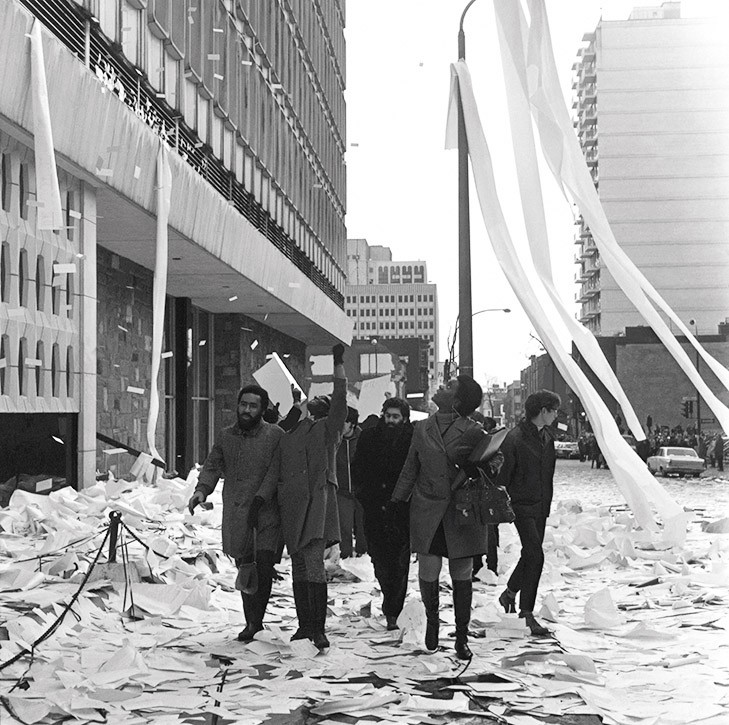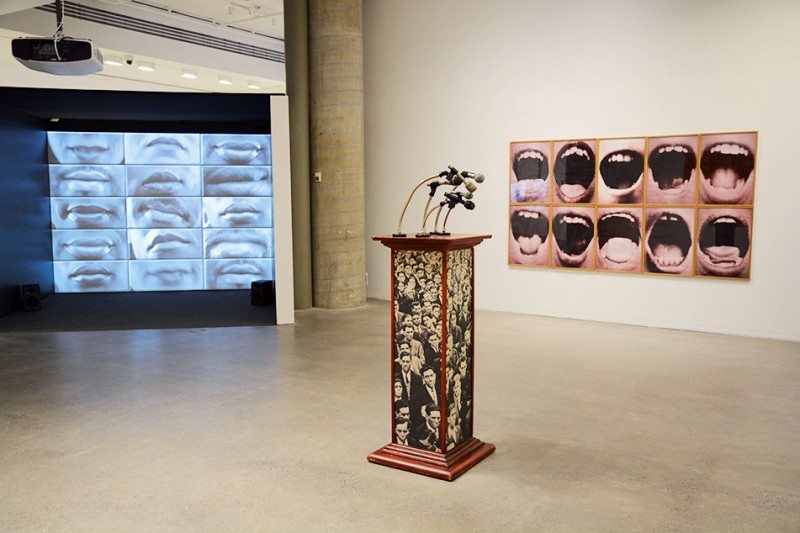“Soulèvements/Uprisings”
To someone whose research focuses on aerial perspectives, the notion of “uprising” has a particular weight to it. In taking stock of the world from above, you variously visualize a hierarchical system that is based on a vertical model, be it in the form of drone surveillance of contested territories or seeing skyscrapers from above. To describe an uprising in terms of weight may seem oxymoronic—“to rise” is to suggest a kind of weightlessness or a disobedience to the laws of gravity. However, an uprising is not weightless; it is heavy, corpulent, dense, and it is in this mass that it finds momentum. As Elias Canetti reminds us, “A large number of people together refuse to continue to do what, till then, they had done singly.”
But let’s not mistake the act of floating with that of rising up—the ascension in the former being a consequence of physics, while the latter finds its propulsion in the thrust of desire—a notion much attended to by art historian and philosopher Georges Didi-Huberman in his ambitious project “Soulèvements/Uprisings.” Hosted and circulated by Jeu de Paume, Paris, the exhibition comprises an extensive collection of images and objects, housed in near equal parts at Galerie de l’UQAM and the Cinémathèque Québécoise, and includes a lecture series, symposium and screening program, featuring such classic films of resistance as Harun Farocki’s and Andrei Ujica’s Videograms of a Revolution, Chris Marker’s Grin without a Cat and Sergeï Esenstein’s The Strike.

Anonymous, Untitled (Computer Center Riot, Sir George Williams University, Montreal) , 1969. Courtesy of Montreal Gazette, a division of Postmedia Network Inc.
Desire, offers Didi-Huberman, referencing the likes of Marcuse and Hegel, is an integral aspect of the gesture of rising up, manifested in human form as an “essential becoming,” which advances towards a being for others. This latter form of desire can be achieved in myriad ways, namely by submission (from below) and domination from (above). What the images and forms of “Soulèvements/Uprisings” offer is a kind of Aby Warburg-inspired catalogue of movement—an atlas of kinesis and dynamis; an assemblage of below and above. In putting together this impressive collection, Didi-Huberman confronts one of Warburg’s earliest questions in how movement can be represented in static pictures. It was this challenge of imaging action that had me approach the exhibition with some trepidation, fearing that the amassing of so many diverse acts of resistance might cause them to coagulate and, in the end, represent another kind of stasis, where erudite discourse dissolves a potency inherent in gestures that began with humble roots and colloquial language. I also worried that metaphors of scaling or breaking walls might come to diminish the practical instances of border conflicts—that sitting comfortably in a colloquium discussing political injustice might do little to ease the burden of, for example, the caravan of Central Americans sitting presently in squalor at an actual wall at the American/Mexican border.
However, Didi-Huberman has achieved, partly through sheer volume and the manner of its organization, an imagistic “crowd” that embodies the four attributes as identified by Canetti in his 1960 treatise Crowds and Power: 1) the crowd always wants to grow; 2) within the crowd there is equality; 3) the crowd loves density; 4) the crowd needs a direction. The exhibition, in its range of images, harnesses a generative power through its repetition of forms—of arms raised and mouths open; of bodies, vertical and horizontal—and recalls other iconic images that share the same revolutionary spirit from our internal archives so that an image of the Quebec student strikes by Mario Jean triggers Delacroix’s Liberty Leading the People, which in turn calls up Gericault, and then Alberto Korda, who gives to Goya and so on…. This propulsion achieves what Didi-Huberman intended, which is for the images to “interact in a dialogue beyond the differences of their times.”

Installation view, “Uprisings,” 2018, curator: Georges Didi-Huberman, Galerie de l’UQAM, Montréal. Works by Lorna Simpson, Dominique Blain, Graciela Sacco. Courtesy Galerie de l’UQAM, Montréal.
I found strikingly relevant the philosophical discourse accompanying the exhibition in the form of public lectures and a formidable catalogue housing essays by contemporary heavy-hitters such as Nicole Brenez, Judith Butler, Marie-José Mondzain, Antonio Negri and Jaques Rancière, with Didi-Huberman at the helm. At the heart of the larger conversation are notions of power, potency and desire, rigorously examined at various angles, which, in the end, point to our present fragile moment in desperate need of its own uprising. To this end, Heidegger and Hegel’s musings on the individual versus the collective appear to me almost epiphanic in revealing the manner in which Western society, seduced as it has become by the reflection of its many digital selves, has dedicated much time to creating a fragile altar to individualism and in doing so has effectively dismantled the potency of the collective in the desire to become “special” (like everyone else).
Broken into five sections—“With Elements (unleashed),” “With Gestures (intense),” “With Words (exclaimed),” “With Conflicts (flared up),” “With Desires (indestructible)”—and having travelled to Barcelona, Buenos Aires, São Paulo and Mexico City, the Montreal (and final) version of the exhibition has been enhanced with archives, press photos and works by contemporary Canadian and Quebec artists. Rebecca Belmore’s video The Blanket, 2011, Michael Snow’s Solar Breath (Northern Caryatids), 2002, and Shary Boyle’s black and white looped film Silent Dedication, 2013, are just a few notable examples in a show stocked with powerful work by such international art historical revolutionaries as Joan Miró, Raoul Haussmann and Tina Modotti. In Belmore’s and Snow’s videos, cloth is an integral compositional element: in the former, it is a red wool blanket—its saturated crimson almost electric against the whiteness of the snow underneath the Indigenous woman it envelops; in Snow’s iconic video, it is a pale, faded curtain, which is pushed out and away and then forcefully pulled back in by atmospheric pressure created through an open window.
Although necessarily divided into sections, the exhibition maintains a cohesiveness that proves to be a moving example of the transformation of human potency to power. We see via the many images of uprisings that, despite geographic differences, there are corporeal registers of resistance that remain universal. The refusal may be internal, but no less defiant, as evidenced in Enrique Ramirez’s Cruzar un Muro, 2013, a short film inspired by the 13th article of the Universal Declaration of Human Rights, which states that everyone should have the right to leave a country, including their own, and to return to that country. Based on the gesture of waiting, in this case for what appears to be matters pertaining to immigration, we are again reminded (if we care to be) of the fact that the simple acts that unite us are more common than those that divide. Put in the context of the entire exhibition replete with narratives of fiercely saying “no,” we see the potency emerge when singular, otherwise quotidian, gestures—such as walking, standing, shouting—are made multiple and synchronous, and desire decides upon a definition of freedom that goes beyond individual choice to recognize that liberty, like the individual, requires a system and an environment to sustain it.
“Soulèvements /Uprisings” was exhibited at Galerie de l’UQAM, Montreal, from September 7 to November 24, 2018, and at Cinémathèque Québécoise, Montreal, from September 7 to November 4, 2018.
Tracy Valcourt lives and writes in Montreal, where she is pursuing her PhD in Humanities at the Centre for Interdisciplinary Studies in Society and Culture at Concordia University.

